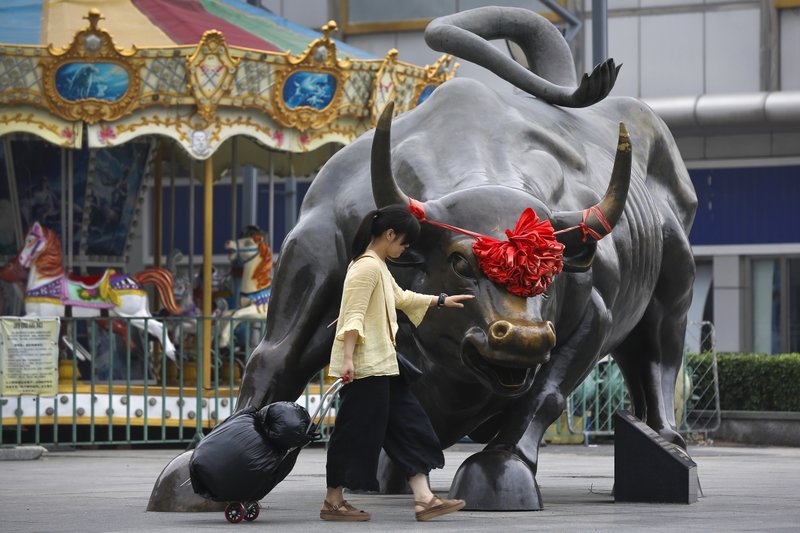BEIJING -- Chinese exporters were scrambling Monday to cope with a plunge in U.S. sales while China's state press shrugged off the effect of Washington's tariff increases in a spiraling technology dispute.
The impact of tariffs imposed Friday on the world's second-largest economy should be limited, according to private sector analysts. But President Donald Trump's measures targeting Chinese medical, construction and factory equipment hit exporters that say price-conscious American customers have stopped buying.
The general manager of a medical device exporter that makes 15 percent to 20 percent of its sales to the United States said he plans to fly to the U.S. this week to negotiate with customers who stopped ordering its syringes and other equipment.
Wuxi Yushou Medical Devices Co. Ltd., with a workforce of 500, stands to lose $4.5 million to $6 million in annual revenue, according to the manager, Miao Liping.
Without new orders, "I will suspend making the products," said Miao. "It is not easy for us to compete with low-end products in other countries."
Other exporters of goods, from kitchen appliances and lighting to toys and tools, have reported similar drops in U.S. orders.
The state press tried to downplay the effect on China, emphasizing what Beijing says will be the bigger blow to American consumers who will pay more for Chinese goods.
China can find other suppliers for soybeans and other American goods hit by its own retaliatory tariffs, state media said.
Despite official bravado, the conflict adds to mounting economic challenges for Beijing.
Economic growth in China already was cooling after regulators tightened controls last year on bank lending to cool surging debt. That spooked investors, who have driven the main stock market index down 21 percent from its Jan. 24 peak.
Trump raised tariffs on $34 billion of Chinese goods in response to complaints Beijing steals or pressures foreign companies to hand over technology.
More broadly, American officials worry Chinese government plans such as "Made in China 2025," which calls for creating competitors in robots, biotech, artificial intelligence and other fields, might erode U.S. technology leadership and prosperity.
Beijing retaliated for the U.S. move by hiking tariffs on American goods including soybeans, whiskey and electric cars. Regulators appeared to be trying to minimize the cost to China by picking goods available from Brazil, Russia, Southeast Asia or other suppliers.
"It won't be difficult for Chinese companies to find replacements for U.S. goods," said Bai Ming, a researcher at the Chinese Academy of International Trade and Economic Cooperation, quoted by the newspaper Global Times.
Alternative suppliers such as Europe, Australia and Brazil "will be likely winners," Rajiv Biswas of IHS Markit said in a report.
A Commerce Ministry statement said Beijing will use revenue from the higher import duties to "alleviate the impact on enterprises and employees" but gave no details. It said importers would be encouraged to shift to buying soybeans and other farm goods from countries that aren't affected by the tariffs.
Still, soy-producing states like Iowa and Illinois might not feel the tariffs' impact right away. China buys so much soy from the United States -- $14 billion last year -- that it can hardly switch to new suppliers overnight. Foreign-grown soybeans are a key source both of low-cost protein for feeding livestock and of cooking oil for Chinese kitchens.
China is pressing its own farmers to grow more. But the math is daunting and the obstacles formidable.
China's increasingly wealthy people want more and better food on their plates. But the country's farms are generally too small and underdeveloped to keep up.
Nearly 90 percent of the soybeans China consumed last year came from overseas -- more than 100 million tons in total. (Mexico, the world's No. 2 importer, bought just 5 million tons.)
The United States buys about 20 percent of China's overall exports, but trade has shrunk as a share of the Chinese economy.
Still, the effects could spread as Chinese factory demand for components from Japan, South Korea, Taiwan and Southeast Asia slumps.
That could cut next year's Asia-Pacific economic growth by up to 1 percentage point, according to Biswas.
Meanwhile, China's entirely state-controlled media have been ordered to avoid "aggressive language" in describing Trump, the South China Morning Post newspaper in Hong Kong reported, citing unidentified sources.
It said that might be intended to avoid antagonizing the American leader and hindering negotiations.
Other exporters including makers of solar panels already were stepping up marketing in Asian and other markets. They are trying to make up for the loss of U.S. and European sales following higher tariffs imposed over complaints they sell at improperly low prices.
Solar exporter Jiangsu Akcome Science & Technology Co. makes about 15 percent of its sales to the United States, while Japan and South Korea are 25 to 30 percent, its general manager, Hu Jingnang, told the newspaper Wuxi Daily.
"The ability to increase global resource allocation can effectively offset foreign trade risks," Hu was quoted as saying.
Information for this article was contributed by Joe McDonald and Yu Bing of The Associated Press and by Raymond Zhong of The New York Times.
A Section on 07/10/2018
